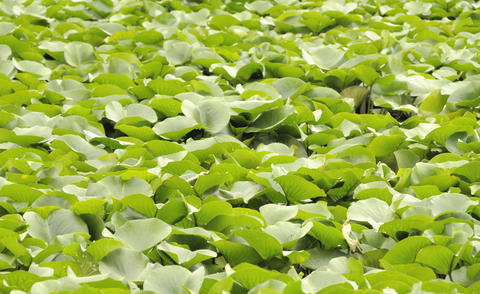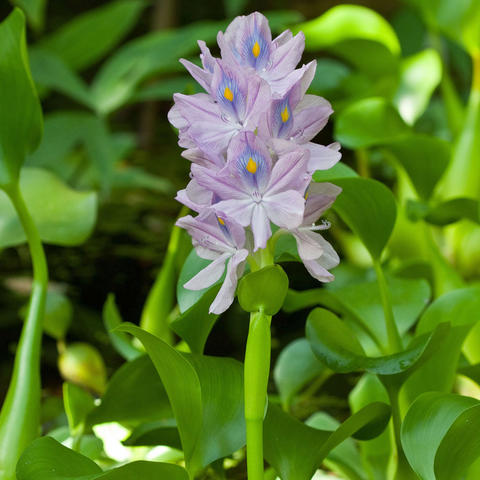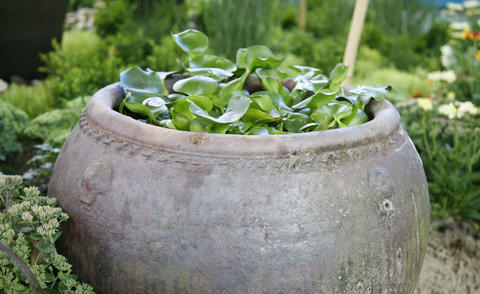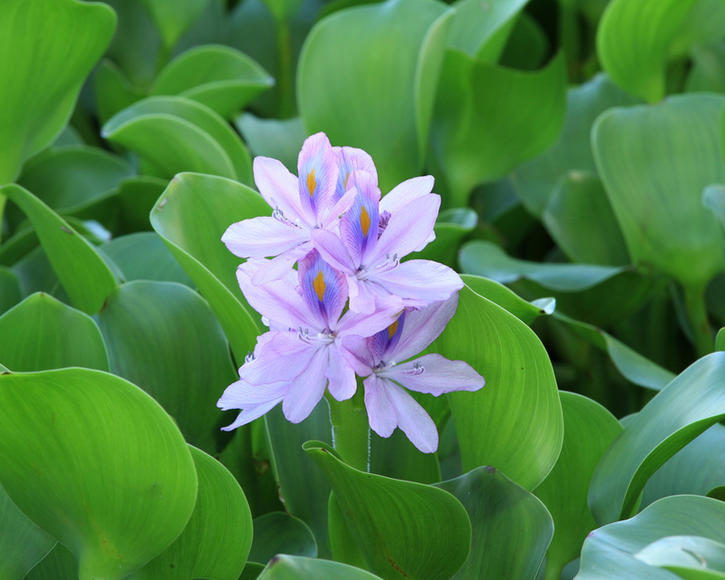Common Water Hyacinth
The Common Water Hyacinth looks pretty in garden ponds and rapidly forms dense stocks. However, as it spreads so readily, there are a few points to observe when planting and caring for this floating plant.
Factsheet
- Growth type
-
- Perennial plant
- Water plant
- Growth height (from)
- from 10 cm to 20 cm
- Growth width (from)
- from 20 cm to 30 cm
- Growth characteristics
-
- rosette-forming
- Flower color
-
- purple
- Flowering time (month)
-
- July to September
- Flower shape
-
- ear-like
- Leaf color
-
- green
- page format
-
- round
- Sheet properties
-
- Floating leaves
- Fruit shape
-
- Capsule
- Light
-
- sunny
- Soil Moisture
-
- Water
- ph value
-
- neutral
- Nutrient requirements
-
- nutrient-rich
- Decorative or utility value
-
- Flower Decoration
- Leaf ornaments
- Toxicity
-
- non-toxic
- Winter Hardness
-
- frost-sensitive
- areas of life
-
- W8
- Use
-
- Pond planting
- Garden style
-
- Water garden
The Common Water Hyacinth (Eichhornia crassipes) belongs to the Pontederiaceae family and is originally native to Brazil. If you look closely, you can see the parallel leaf veins which characterize it as a monocotyledon. Thanks to the balloon shaped petioles, the leave float on the surface of standing or slow-flowing water.
This floating leaf plant is now not only known in its native country, but it has also become a plague in other tropical areas of Africa and China, as in good growing conditions it displaces native species, clogs entire bodies of water and overloads with nutrients. In some regions, this excess is used and their stems are tried and woven into baskets or furniture or used as green fertilizer. To prevent uncontrolled spreading in nature, the EU placed the Common Water Hyacinth on the ‘List of invasive alien species’ in 2016. This means it is no longer available for purchase. They may not become problematic in our climate, however you should never place common water hyacinth specimens in natural bodies of water. A closely related species which is also used as a decorative plant in garden ponds is the anchored water hyacinth (Eichhornia azurea).

The Common Water Hyacinth is a floating leaf plant which grows on the surface of the water and rapidly forms dense stocks under good growing conditions. Its roots can grow up to 16 inches long and it draws lots of nutrient from the water.
The Common Water Hyacinth forms fleshy, bright green leaves with each inflorescence which are arranged as a leaf rosette and grow on the water. The inflated petioles function as floating bodies as they contain an air filled, sponge-like tissue.
The light violet flowers of the Water Hyacinth form an ear inflorescence with protrudes out of the water. They only develop in warms summers with plenty of humidity from July to September. Each individual flower has a pretty, yellow marking.

After pollination by insects, capsule fruit or nuts appear from the flowers of the Water Hyacinth. However, we do not generally have warm enough temperatures for this.
The Common Water Hyacinth grows in still or extremely slow flowing bodies of water with a depth of at least 3.94 inches. The water should warm up quickly, a place in the full sunshine with nutrient-rich water is idea. This exotic specimen adapted for the tropics also does well in mini ponds, barrels or vats as the water also quickly warms up in these. The warmer and more humid the summer, the more reliable the striking flowers are to develop. The extremely frost-sensitive Common Water Hyacinth may only be planted from May and should be taken out to overwinter in October at the latest.
As Water Hyacinths are floating leaf plants which do not anchor to the floor of the pond, you can simply place them in the position you want in a body of water from May, after the frosts are over. You need about two to three plants per square yard. Keep the amount more reserved at the start and observe how the stocks develop.

In years with good growing conditions, it may be necessary to thin the Common Water Hyacinth now and again so that it doesn’t clog up the entire pond. You can thin it by simply fishing a few specimens out of the water or separating a few offshoots. Overwintering the tropical Water Hyacinth is quite strenuous as it requires a very bright winter residence with temperatures of at least 59 and preferably 68 degrees Fahrenheit. A flat bowl filled with loamy soil and water is a suitable overwintering container, or you can use an aquarium or a water beaker with a minimum water depth of 8 inches.
The Common Water Hyacinth requires at least 12 hours of light during the day, which can only be achieved during the darker times of year with additional lighting. Temperature fluctuations should be avoided; a heated conservatory is ideal. As Water Hyacinths do not take a break under these conditions, they should be supplied with regular nutrients in addition to watering. Use a special fertilizer for aquatic plants and follow the dosage instructions. The plants should only be placed back in the pond in May when you are certain that the frosts are over. If you find overwintering too strenuous or you don’t have suitable overwintering options, you can also grow this exotic aquatic plant as an annual and obtain new plants every spring. In this case, fish the Common Water Hyacinth out of the pond with a net in the fall and put it on the compost. This prevents the plant from dying due to the cold and from sinking into the ground, thereby preventing to burden the water unnecessarily with extra nutrients.
If the Common Water Hyacinth spreads quickly in good growing conditions, it may be necessary to divide the plant during its growth phase by separating the offshoots and disposing of parts of the plant, or gifting them to another hobby gardener.

Like many other aquatic plants, the common water Hyacinth cleanses the water of harmful substances and nutrients and is therefore a natural water filter. Its dense leaves provide shade for the area below it and suppress excessive algae growth. Its striking color and exotic appearance mean the common water hyacinth can sometimes look alien in a natural pond, however this is a matter of personal taste. It creates a stylish scene in formal ponds or wide water channels.
The Common Water Hyacinth can be easily propagated through offshoots. Fruit and seeds only form in the tropics and do not work in our climatic conditions. To propagate, simply cut off an offshoot and then place it in the desired location. An independent plant will quickly grow from this and create new offshoots.
Neither are an issue: Water Hyacinths are neither susceptible to diseases nor bothered by pests.

